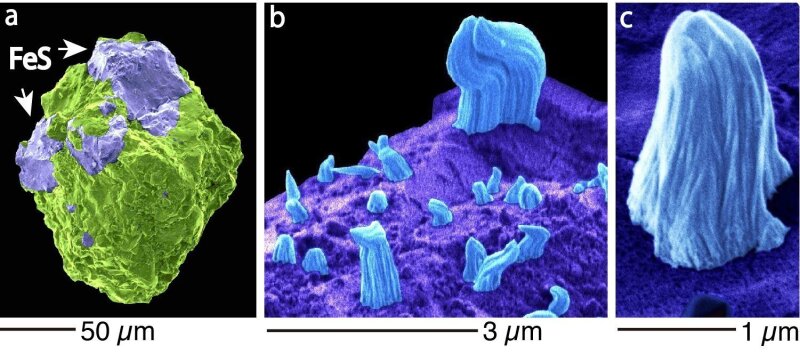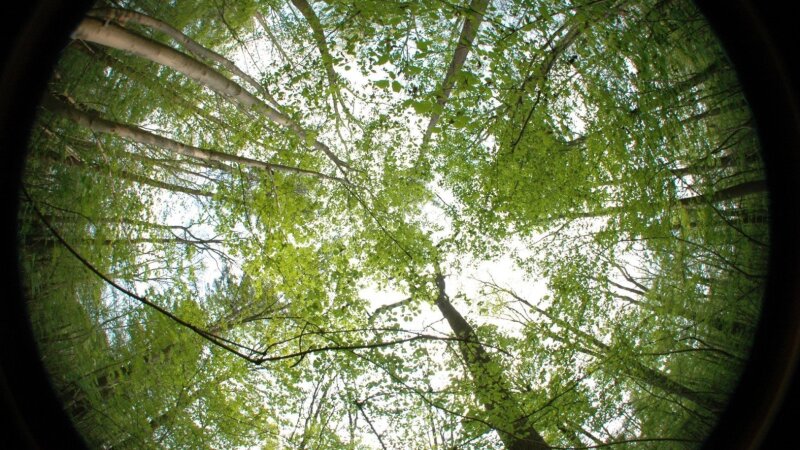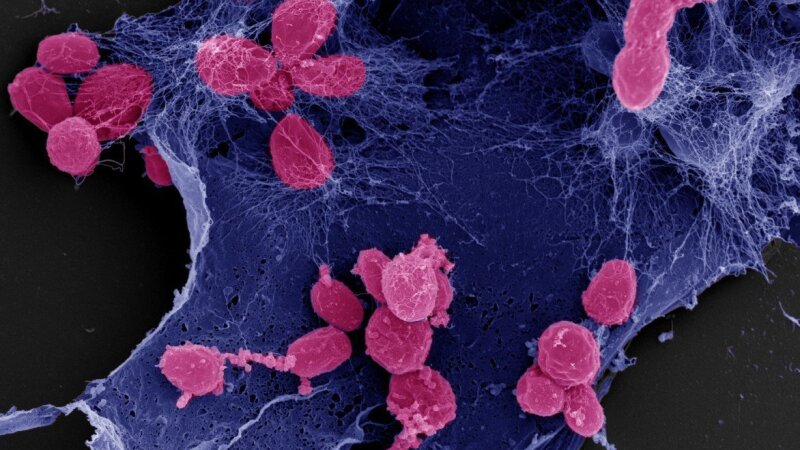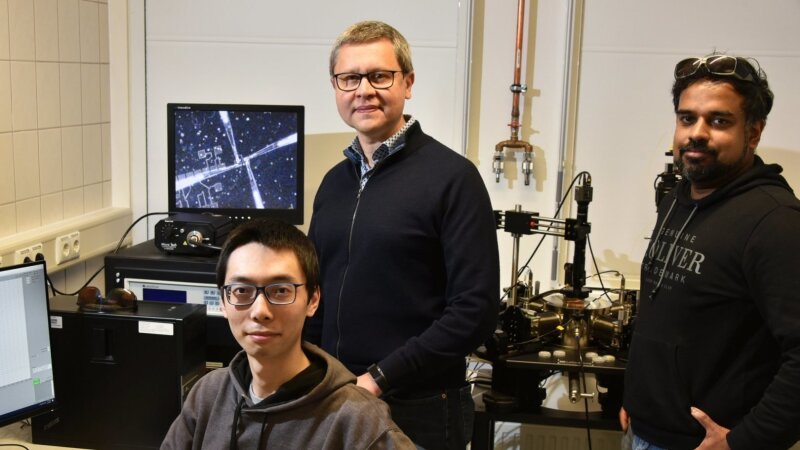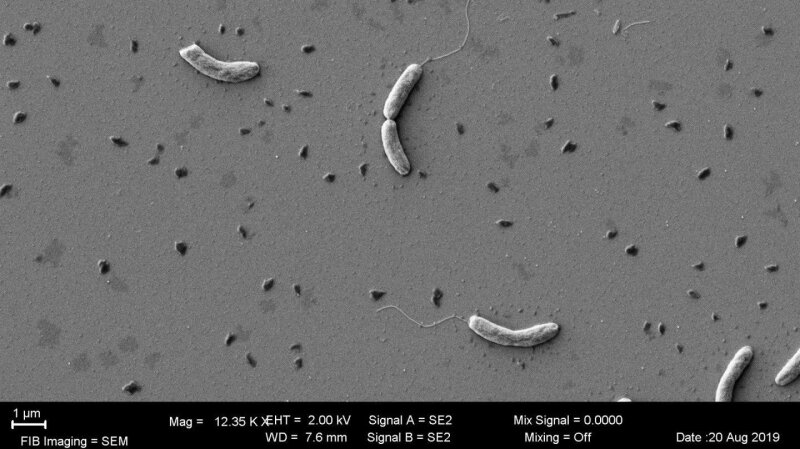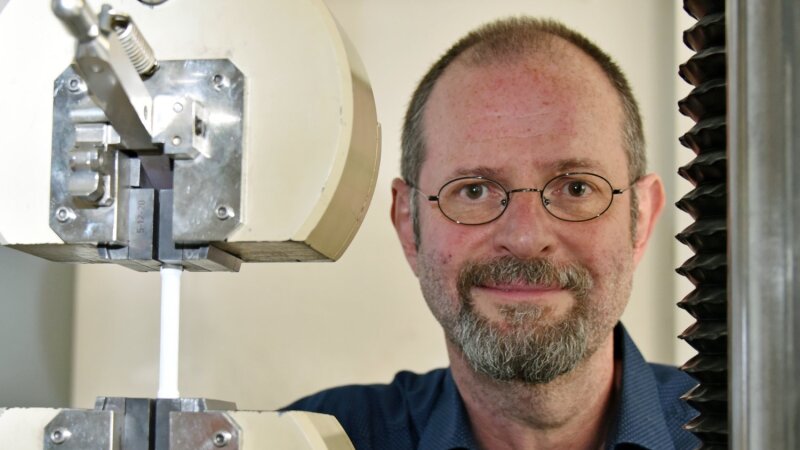Ticker
Asteroid in iron armour
Mineralogists from Jena and Japan have discovered a previously unknown phenomenon in soil samples from the asteroid »Itokawa«: The surface of the celestial body on which the Japanese probe Hayabusa landed in 2005 is covered with tiny hair-shaped crystals of iron. Prof. Dr Falko Langenhorst, Dr Dennis Harries and Dr Toru Matsumoto found these crystals using high-resolution images taken by a transmission electron microscope and explain their formation in the journal »Nature Communications«External link. »These structures are the result of cosmic influences on the asteroid's surface«, explains Falko Langenhorst. In addition to rocks, high-energy particles of the solar wind also hit the asteroid's surface, causing it to weather. As a result of space weathering, iron is released from the mineral troilite, of which the asteroid is largely composed, and is deposited on the surface in the form of tiny needles. [US]
Microscopic image in false colours. (a) One of the examined dust particles of the asteroid Itokawa. The mineral troilite (FeS, violet) is surrounded by silicate (green). (b) Troilite surface (violet) with iron hairs (blue). (c) Iron crystal magnified.
Picture: Toru MatsumotoEternal love can be predicted
Is it possible to predict at the beginning of a partnership how long it will last? Psychologists from the Friedrich Schiller University Jena and Alberta University (Canada) can answer this question with a definite yes: »It is possible to predict how long a relationship will last«, says Dr Christine Finn. The Jena psychologist has accompanied almost 2,000 couples over seven years in the »pairfam« long-term study. One in six relationships broke up during this period. »But even at the beginning of a relationship, predictive variables can be found that provide information about whether the relationship will last long or not.« The research team describes what these variables are in the journal Developmental PsychologyExternal link. According to the research, couples who stay together and couples who break up are already at different levels of happiness at the beginning of their relationships. In the course of time, happiness decreases in both groups – but this happens much more rapidly in those who separate later. [sh]
Separations hurt, but can be predicted to a certain extent.
Image: Anne Günther (University of Jena)Dense leaf canopy protects against rising temperatures
Forests are among the most important ecosystems on earth, and a large proportion of all terrestrial animal and plant species have their habitat in them. An international research team with the participation of Jena ecologist PD (adjunct lecturer) Dr Markus Bernhardt-Römermann has now systematically determined global warming in forests and published the results in the »Science« research magazineExternal link. As it turns out, the climate changes measured so far mainly in the open field do not adequately reflect the temperature development in forests. This is because under the leaf canopy of a forest there are usually significantly cooler, shadier and usually also more humid conditions. And this is precisely what makes the forest ecosystem particularly vulnerable: A loss of the protective treetops – for example through pest infestation, summer drought or forestry management – results in an additional, drastic warming for the plant and animal species living below, which threatens their populations. [sh]
Hemispherical photo of a beech population.
Image: Pieter de FrenneWater bacteria have a green thumb
Jena microbiologists led by Prof. Dr Christian Jogler have discovered Stieleria maiorica, a new species of bacteria, which they used to detect natural substances that help these aquatic microorganisms to control the composition of biofilms on aquatic plants and algae. The previously unknown group of chemical compounds are relatively small molecules which the research team has named »Stieleriacine«. As the researchers show in their study published in the journal »Communications Biology«External link, »Stieleriacine« have the effect of inhibiting the growth of other microbial species that compete with Stieleria maiorica for habitat and food. In contrast, other species from which Stieleria maiorica can benefit are promoted in their growth. In this way, the water bacteria are able to adapt their environment to their own needs and, like skilled gardeners, regulate the growth of other species. [US]
Scanning electron microscope image of Stieleria maiorica. Cells in pink. Matrix in blue.
Image: Manfred Rohde/HZI BraunschweigBright buttons
A research team from the Friedrich Schiller University Jena and the National Metrology Institute of Germany (Physikalisch-Technische Bundesanstalt) has developed novel nano-switches that can be operated by light signal. In the journal »Chemistry A European Journal«External link, the research team around Prof. Dr Andrey Turchanin presented their concept of a photoswitchable field effect transistor. It uses ultra-thin intelligent materials: a conductive layer of graphene combined with a single molecular layer containing functional azobenzene units. The tiny transistor works like this: When a voltage is applied, a current flows through the graphene layer. When UV light is added, the dipole properties of the azobenzene units change and an electric field is induced in the underlying graphene, which interrupts the current flow. If, on the other hand, the transistor is irradiated with blue light, the configuration changes again, which means that current flows again. The light-driven nano-switch is ready. [US]
Zian Tang (l.), Prof. Andrey Turchanin and Antony George (r.) in a laboratory in which X-ray photometric spectra of intelligent nano-materials are recorded.
Image: Anne Günther (University of Jena)Incense reprograms inflammatory enzyme
A research team from the Friedrich Schiller University Jena and Louisiana State University (USA) has clarified the molecular mechanism of the anti-inflammatory effect of boswellic acid, a substance from the resin of the incense tree. The researchers led by Prof. Dr Oliver Werz report on this in the journal »Nature Chemical Biology«External link. The enzyme 5-lipoxygenase plays a key role in inflammatory processes: The normally pro-inflammatory enzyme undergoes a structural change through the binding of boswellic acid, which results in an anti-inflammatory effect. The specificity of the enzyme also changes. Instead of catalysing the synthesis of pro-inflammatory leukotrienes, 5-lipoxygenase produces anti-inflammatory substances under the influence of boswellic acid. The research team was able to elucidate this mechanism by means of crystal structure analyses and to map it for the first time. [US]
Frankincense resin from Africa (l.) and India. Extracts of this resin can reduce inflammation.
Image: Jan-Peter Kasper (University of Jena)New ribonucleic acid identified in cholera pathogen
A team led by the Jena microbiologist Prof. Dr Kai Papenfort has discovered the previously unknown small ribonucleic acid FarS in cholera pathogens (Vibrio cholerae). This molecule plays an important role in the fatty acid metabolism of the pathogen and is therefore a decisive factor in the outbreak of cholera disease once the pathogen has entered the intestine. The extent to which the bacteria can multiply in the intestinal tract depends on the concentration of certain fatty acids. The Jena research team has therefore investigated how bacterial genes responsible for fatty acid metabolism are regulated and, in the process, have become aware of the ribonucleic acid FarS. As the research team writes in the journal »Proceedings of the National Academy of Sciences«External link, FarS, together with other factors, regulates the biosynthesis and degradation of fatty acids in V. cholerae. [AG]
Electron microscope image of the cholera pathogen (vibrio cholerae).
Image: Kai PapenfortControlling cells with light
Photopharmacology is concerned with switching the effect of medicines on and off with light. Now, for the first time, scientific teams from Jena, Munich and New York have succeeded in using this method to control a component of the cells that was previously considered to be inaccessible: the actin cytoskeleton. The team led by Prof. Dr Hans-Dieter Arndt has developed a light-sensitive substance from a natural substance – called optojasps – which blocks actin molecules in cells as soon as they are irradiated with violet light. After a certain time, or when green light is applied, the optojasp returns to its inactive basic structure. Because actin is an essential component of the cytoskeleton of cells, individual cells can be specifically manipulated in this way. The movement of certain cells can also be controlled with this technique, the researchers report in the journal »Journal of the American Chemical Society«External link. [MK]
The new drug called Optojasp only becomes active when violet light irradiates it.
Image: Jürgen Scheere (University of Jena)Self-healing bone cements
Materials scientists at the University of Jena have further developed a bone replacement material that can not only repair existing damage to the bone, but also regenerate itself. They report on this in the research magazine »Scientific Reports«External link. The material is calcium phosphate cement. This bone replacement material is already frequently used in medicine, but is not suitable for load-bearing bone repairs due to its brittleness. The Jena researchers in Prof. Dr Frank A. Müller's team have reinforced the material with carbon fibres. This modification gives the material the ability to self-heal fractures or injuries. In addition to the greater load-bearing capacity associated with the fibre reinforcement, the areas of application for bone implants made of calcium phosphate cement could thus be considerably expanded to include load-bearing skeletal areas in the future. [sh]
Prof. Dr Frank A. Müller, Chair of Colloids, Surfaces and Interfaces at OSIM.
Image: Anne Günther (University of Jena)Detecting gravitational waves in the nanohertz range
After receiving gravitational wave signals for the first time in 2015, which are the result of the fusion of two black holes, astrophysicists now want to detect gravitational waves in the nanohertz range, which black holes generate long before they implode, while orbiting each other. An international research team has now succeeded in doing this with the help of NASA's Spitzer Space Telescope at the cosmic object OJ 287 – about four billion light years away from Earth in the constellation of Cancer. OJ 287 is a pair of supermassive black holes orbiting at a period of twelve years. The team, which includes astrophysicist Dr Markus Mugrauer and physics student Felix Hildebrandt from the University of Jena, has now been able to prove the gravitational waves in the nanohertz range emitted by these black holes by indirect observations. The measurement data has been published in the »Astrophysical Journal Letters«External link. [US]
Artistic illustration of the centre of OJ 287, in which two black holes orbit each other.
Picture: NASA/JPL-Caltech